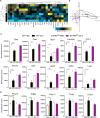Activation of the STING-Dependent Type I Interferon Response Reduces Microglial Reactivity and Neuroinflammation
- PMID: 29268096
- PMCID: PMC5806703
- DOI: 10.1016/j.neuron.2017.11.032
Activation of the STING-Dependent Type I Interferon Response Reduces Microglial Reactivity and Neuroinflammation
Abstract
Brain aging and neurodegeneration are associated with prominent microglial reactivity and activation of innate immune response pathways, commonly referred to as neuroinflammation. One such pathway, the type I interferon response, recognizes viral or mitochondrial DNA in the cytoplasm via activation of the recently discovered cyclic dinucleotide synthetase cGAS and the cyclic dinucleotide receptor STING. Here we show that the FDA-approved antiviral drug ganciclovir (GCV) induces a type I interferon response independent of its canonical thymidine kinase target. Inhibition of components of the STING pathway, including STING, IRF3, Tbk1, extracellular IFNβ, and the Jak-Stat pathway resulted in reduced activity of GCV and its derivatives. Importantly, functional STING was necessary for GCV to inhibit inflammation in cultured myeloid cells and in a mouse model of multiple sclerosis. Collectively, our findings uncover an unexpected new activity of GCV and identify the STING pathway as a regulator of microglial reactivity and neuroinflammation.
Keywords: STING; experimental autoimmune encephalomyelitis; ganciclovir; microglia; neuroinflammation; type I interferon response.
Copyright © 2017 Elsevier Inc. All rights reserved.
Figures








Comment in
-
United Again: STING and the Police.Neuron. 2017 Dec 20;96(6):1207-1208. doi: 10.1016/j.neuron.2017.12.015. Neuron. 2017. PMID: 29268089
References
-
- Alexa A, Rahnenfuhrer J. topGO: enrichment analysis for gene ontology. R package version 2.16.0 2010
-
- Andrews S. FastQC: a quality control tool for high throughput sequence data 2010
Publication types
MeSH terms
Substances
Grants and funding
LinkOut - more resources
Full Text Sources
Other Literature Sources
Medical
Molecular Biology Databases
Research Materials
Miscellaneous

